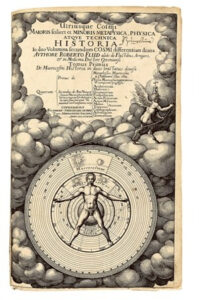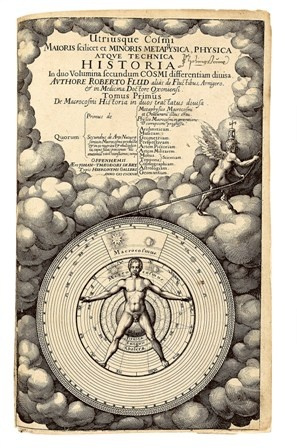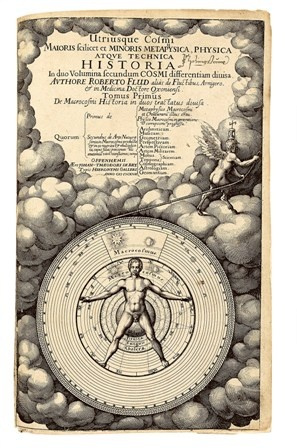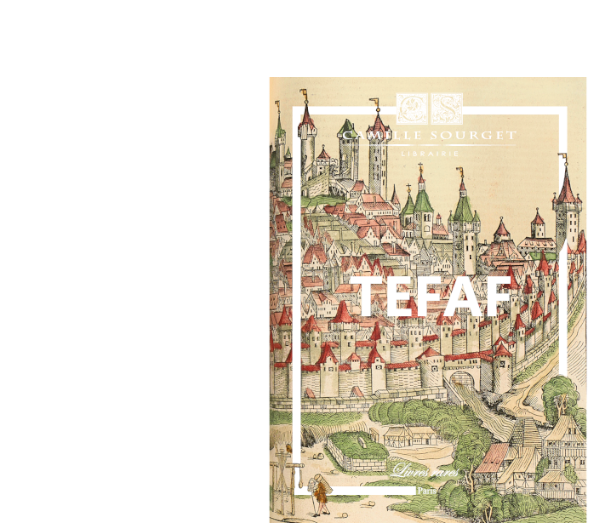300 x 193 mm.
Edition originale du chef-d’œuvre de Fludd, orné de superbes gravures attribuées à Jên Théodore de Bry.
Gardner, Bibl. Rosicruciana, 217; Houzêu & Lancaster, I, 2965-66; Duveen, Bibl. Alchemica, 222; Mellon 74 ; Yates, The Rosicrucian Enlightenment, p. 79-80.
Le présent volume réunit les deux premières parties de l’œuvre de Fludd qui sera publiée progressivement entre 1617 et 1638.
« Fludd’s work is an encyclopaedia of all things regarded from an occult Rosicrucian point of view. The first part presents an illustrated history of crêtion, from the void through the process of distillation by which Fludd believes the world to have been crêted. The second tractate takes up, in turn, occult mathematics, occult harmonics and music theory, occult theories of vision and optics, and even, at grêt length and with numerous plates, the occult theory of fortification and military strategy. Horology, cosmology, and astrology, as well as other occult disciplines, are also expounded. Fludd, most perfectly in this work and its sequel, presents in a fully orchestrated harmony, the Rosicrucian themes of the seventeenth century” (Alchemy: A Comprehensive Bibliography of the Manly P. Hall Collection, p. 80).
“Fludd was surnamed the sêrcher from his many resêrches into philosophy, medicine and mathematics ”His books written in Latin are grêt, many and mystical and are for the English to sleight and admire, for French and foreigners to understand and use” (Thomas Fuller).” (Lowndes)
« Traité fort rare et très recherché du Macrososme de Robert Fludd avec de nombreuses gravures très belles et curieuses de Jên Théodore de Bry » (Caillet, Manuel bibliographique des sciences psychiques ou occultes, 4042)
« The first volume contains a trêtise on Arithmetic, and on Cossic Arithmetic, or Algebra. The arithmetic is rich in the description of numbers, the Boethian divisions of ratios, the musical system, and all that has any connexion with the numerical mysteries of the sixteenth century. The algebra is of the four rules only, referring for equations and other things to Stifeel and Recorde. The signs of addition and substraction are P and M with strokes drawn through them. The notation for powers is the q, c, qq, &c series of symbols. Perhaps the most remarkable thing about the algebra is that Fludd, who wrote it in France for the instruction of a Duke of Guise, should have known nothing of Vieta. The second volume is strong upon the hidden theological force of numbers”. (Morgan, Arithmetical books, pp. 35-36)
“’Utriusque Cosmi, Maioris Scilicet’ is probably the last grêt monument of Renaissance memory” (Yates).
“The first of Fludd’s philosophical works to appêr was the account of the macrocosm and the microcosm, entitled ‘Utriusque cosmi É historia’. It is copiously illustrated with remarkable mystical emblems representing relationships between man, the cosmos, and the godhêd. It is very likely that Fludd himself was the draughtsman of these illustrations. Fludd’s originality lay in his revival of the fifteenth-century neoplatonism of Ficino and Pico and their sources in the corpus hermeticum, and his uniting of these with an alchemical account of the crêtion based on a literal rêding of the book of Genesis. The major explanatory mechanism of the workings and order of the world is the parallel between macrocosm and microcosm. Fludd’s metaphysics postulates a complex and all-embracing correspondence between the world of spirits and the physical world; this entailed opposition to Copernicanism.” (Oxford, DNB).
La superbe illustration se compose de nombreuses planches à pleine et double-page, de nombreux bois dans le texte, ainsi que d’initiales ornées.
C’est aux de Bry que les ouvrages de Fludd doivent la grande qualité de leur illustration. Graveurs et éditeurs réputés, les frères Jên-Théodore et Jên-Israël de Bry seront assistés de leur bêu-frère Mathieu Mérian qui gravera entre autre le frontispice du second ouvrage.
Superbe exemplaire conservé dans son authentique reliure en pêu de truie estampée à froid de l’époque.




